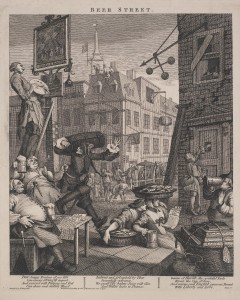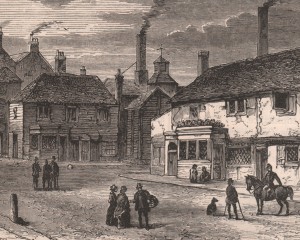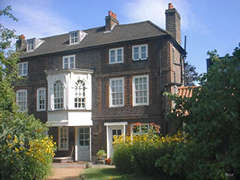Exhibition on Hogarth and Beer Opens
'The Brewer's Art' looks at malting and brewing in Chiswick
The new exhibition in the small gallery at Hogarth's House is The Brewer's Art, which looks at the business of malting and brewing in Chiswick.

Griffin Brewery employees, about 1900
Fuller's Griffin Brewery is lending objects and has been generous with information and images. The William Hogarth Trust hope some people will be able to visit the House and do the brewery tour on the same day.
The two neighbouring breweries, later known as the Griffin and the Lamb, were there before the Hogarths arrived in Chiswick in 1749. The research for the exhibition has thrown up some new and fascinating data; the digitisation of archive catalogues and of actual archives has made the search for information much easier in the last decade. Wills in particular have provided useful details.

Hogarth's Beer Street
Matthew Graves, who was married to a distant cousin of Lord Burlington, leased the Griffin Brewery from 1748; in his will, made in 1778, his bequests included £100 to Mr Huips “who has been the Brewer 21 years, praying his assistance in the management sale and disposition of the brewhouse the business of which I desire may be carried on for two years after my decease and no longer.” The Land Tax records reveal that James Huips, the brewer, lived next door on the east side to the Hogarths. And the trustworthy people who witnessed Graves' will include Julian Bere, a wealthy woman who lived with the Hogarths.

Church Street with the Lamb Brewery, 1870s
The Sich family were connected with the Lamb Brewery from the 1770s until 1920.
John Sich the younger married Ann Ruberry, the daughter of the wealthy farmer at Sutton Court Farm in 1773 and went into partnership to run the brewery in the same year. He was active in the local volunteer regiment during the Napoleonic Wars and master of a Hammer-smith freemasons' lodge.
A long-standing fellow mason in that lodge was Richard Loveday, the Chiswick surgeon who witnessed Hogarth's will. Loveday must have been a frequent visitor to the Hogarths as Jane Hogarth was godmother to one of his daughters. Jane left Hogarth's House to her cousin, Mary Lewis, for life and then to Loveday who inherited on Mary's death in 1808.
This has been prompted by Hogarth's wonderful Beer Street engraving. If the organisers find a sponsor in the future, there could be a gin exhibition as well, built around the Gin Lane print!The exhibition opened to visitors on 6 August and runs until 11 November 2012; the House is open 12 noon to 5pm every day except Monday. Admission is free.
Article adapted from the original published on the William Hogarth Trust web site.
August 11, 2012
Related links
|
